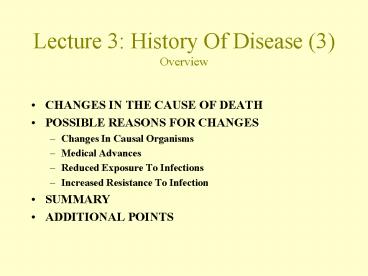Lecture 3: History Of Disease 3 Overview - PowerPoint PPT Presentation
1 / 18
Title:
Lecture 3: History Of Disease 3 Overview
Description:
Medical Advances. Reduced Exposure To Infections. Increased Resistance To Infection ... century saw major advances in the ability of the medical profession to treat ... – PowerPoint PPT presentation
Number of Views:41
Avg rating:3.0/5.0
Title: Lecture 3: History Of Disease 3 Overview
1
Lecture 3 History Of Disease (3) Overview
- CHANGES IN THE CAUSE OF DEATH
- POSSIBLE REASONS FOR CHANGES
- Changes In Causal Organisms
- Medical Advances
- Reduced Exposure To Infections
- Increased Resistance To Infection
- SUMMARY
- ADDITIONAL POINTS
2
Changes In Cause Of Death
- McKeown estimated the contribution of different
diseases to the improvement in life expectancy
(next slide) - ¾ of all improvements were directly due to a
reduction in deaths from infectious diseases.
However, many of the remaining ¼ were also
probably due to reductions in infectious diseases.
3
McKeowns Estimates Of Contribution Of Different
Diseases To Imprements In Life Expectancy
(Abbreviated)
- Airborne Infectious Diseases 40.3
- Tuberculosis 17.5
- Bronchitis, pneumonia, influenza 9.9
- Scarlet fever, diphtheria 6.2
- Waterborne / Foodborne Infections 21.4
- Cholera, diarrhoea, dysentry 10.8
- Typhoid (typhus) 6.0
- Other Infections 12.6
- Other Causes 25.6
- Old age 8.7
- Prematurity, immaturity 6.2
4
Possible Reasons For Improvements
- Changes In Causal Organisms
- Medical Advances
- Reduced Exposure To Infections
- Increased Resistance To Infection
5
1. Changes in Causal Organism
- Diseases can spontanously become more or less
virulent for no obvious reason. - The decline in deaths from scarlet fever may be
an example. - Overall, such changes are probably only a minor
factor.
6
2. Medical Treatment
- The late 19th and 20th century saw major advances
in the ability of the medical profession to treat
infectious diseases. - Marked reductions may be observed in the death
rates from diphtheria and polio following medical
interventions. - Whilst effective, medical interventions for
tuberculosis, measles, whooping cough and
pneumonia arrived long after the major decline in
the death rates. - McKinley and McKinley reported similar findings
for the USA.
7
(No Transcript)
8
(No Transcript)
9
(No Transcript)
10
(No Transcript)
11
(No Transcript)
12
(No Transcript)
13
(No Transcript)
14
3. Reduced Exposure To Infections
- Lower housing densities, made possible by public
transport and enforced by legislation, resulted
in exposure to airborne infections. - Improvements in water supply and sewage disposal
resulted in reduced exposure to waterborne
infections. Likewise pasteurisation of milk
reduced exposure to foodborne infections. - McKeown argues that these improvements were less
significant than might be assumed. However, many
experts disagree.
15
4. Increased Resistance To Infection
- Having eliminated the other three possibilities,
McKeown argues that the improvements must have
been caused by increased resistance to infection
due to better diets.
16
Summary
- McKeowns critics argue that he underestimated
the impact of public health reforms. - He is also criticised for providing no direct
evidence that improvements were due to increased
resistance. - Almost everyone appears to accept his arguments
that curative medicine played a minor role.
17
Additional Observations
- Public reforms with regard to housing quality,
clean water supply and sewage disposal had the
right effect but for the wrong reasons. The
prevailing belief at the time was that diseases
were caused by miasmas (bad smells). - Life expectancies have increased in developed
countries at a much slower rate than the growth
of investment in curative medicine. This suggests
that money might be more effective if spent on
preventive measures. - The increase in deaths from degenerative diseases
such as cancer which mostly affect people in old
age should be seen as positive, indicating a
reduction in deaths at a younger age from
infectious diseases.
18
(No Transcript)































